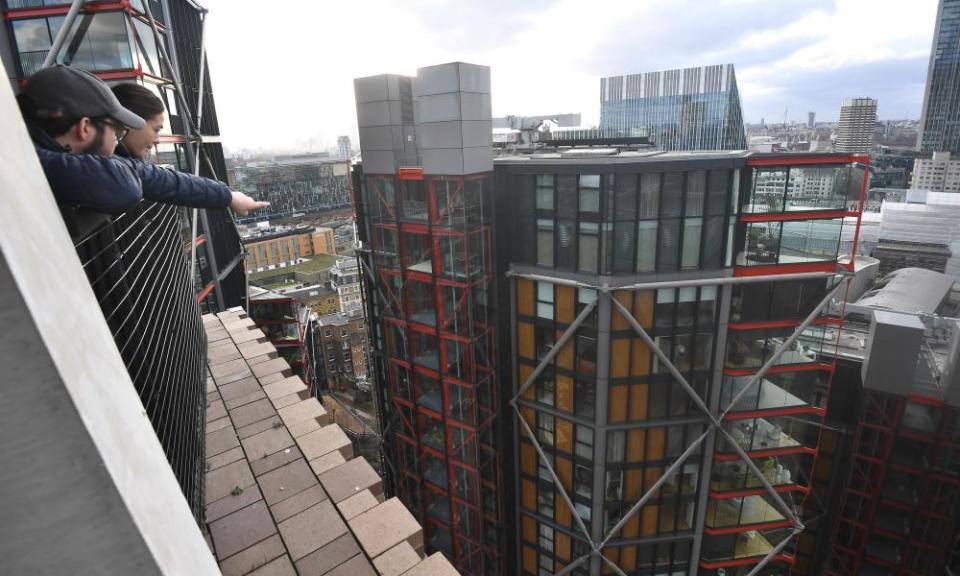Owners of flats near Tate Modern take privacy case to supreme court

Ruling in Neo Bankside residents v viewing platform could potentially have wider implications for neighbour disputes
On one side is Tate Modern. On the other are the owners of nearby luxury apartments objecting to what they regard as the prying eyes of visitors enjoying a viewing platform at Britain’s most visited gallery.
This week those owners will mount their final attempt to block the alleged daily intrusion when the legal battle reaches the UK’s highest court. One result could be a landmark ruling enshrining tenants’ rights to privacy and potentially opening the floodgates to thousands of neighbour disputes.
The case involves five owners of four apartments in the Neo Bankside development on the south bank of the Thames taking action against the Tate over the “hundreds of thousands of visitors” looking into their homes from the viewing platform 34 metres away. The platform, which opened in 2016, provides a panorama of London as well as a direct view into their glass-fronted flats.
In 2017, the owners of the flats applied for an injunction requiring the gallery to cordon off parts of the platform or erect screening to prevent what they said was a “relentless” invasion of their privacy. Judges in two courts ruled against the flat owners, albeit for differing reasons.
In an initial high court ruling in 2019, Justice Mann accepted the argument that overlooking theoretically falls within the scope of existing legal protections against neighbourly intrusion into the home, the tort of nuisance.
Watch: New high tech art floats at London’s Tate Modern
Related: Residents overlooked by Tate Modern extension should 'get net curtains'
However, he decided that the glass-walled design of the flats and their location in central London came “at a price in terms of privacy” and suggested the owners could lower their solar blinds or install privacy film or net curtains. He asked the Tate to limit the hours during which the south and west sides of the viewing gallery could be used.
In 2020 the court of appeal took the view that overlooking could never be considered a private nuisance, but argued that if it could, then it would apply in this instance.
A spokesperson for the law firm Forsters, which is representing the flat owners, said the clients had taken the difficult decision to continue their legal action to “protect their and their families’ right to enjoy their homes”.
“This has been a long journey for our clients. From the outset they have only ever sought to limit very intrusive viewing by the public from a section of the viewing gallery, which enables hundreds of thousands of people a year to peer, photograph, and film directly into their homes at close proximity.”
The case will now be heard by the supreme court, a move considered by legal experts to represent an indication that it is considered a matter of considerable public interest.
“Overlooking and invasion of privacy does not amount to a nuisance in this country, this would overturn everything because it’s never been upheld in the courts of this country before,” said Claire Lamkin, a real estate litigator at the law firm Kingsley Napley.
Lawyers said that if the supreme court ruled in favour of the flat owners, this would effectively create a new strand to the tort of nuisance, to sit alongside existing protections from excess noise and smells as well as against obstruction of natural light.
Watch: A London art exhibit features a room full of swings, and it's perfect for people who hate museums
Related: Neo Bankside: how Richard Rogers's new 'non-dom accom' cut out the poor
This could theoretically open the floodgates to hundreds more cases brought by homeowners who are frustrated with neighbours peering into their properties, as well as placing potentially onerous limitations on the construction of new buildings, unless a clear test is established to ensure the law only applies in extreme cases, such as proximity to a viewing platform.
Donal Nolan, a professor of private law at the University of Oxford, said it would be a difficult case for the supreme court, but ultimately it boils down to two key questions: “Can you bring a claim of this kind, and if you can, is the interference in this particular case unreasonable?”
Nolan added that ordinarily questions of proximity and privacy would be solved through planning rules rather than litigation. “The question is whether you need this planning law backstop if the planning system doesn’t work as it perhaps should do,” he said.
James Souter, a partner specialising in land disputes at the law firm Charles Russell Speechlys, said the mismatch between the two earlier court rulings suggested that everything was “up for grabs”.
He said the supreme court need not worry about the case setting a precedent with too wide an application, as it would be easy to set parameters for extreme examples of overlooking. “It’s going to be such a rare case, there won’t be another one like it, you can barely imagine this intensity of overlooking,” he said.
The Tate declined to comment ahead of the supreme court hearing.

 Yahoo Finance
Yahoo Finance 